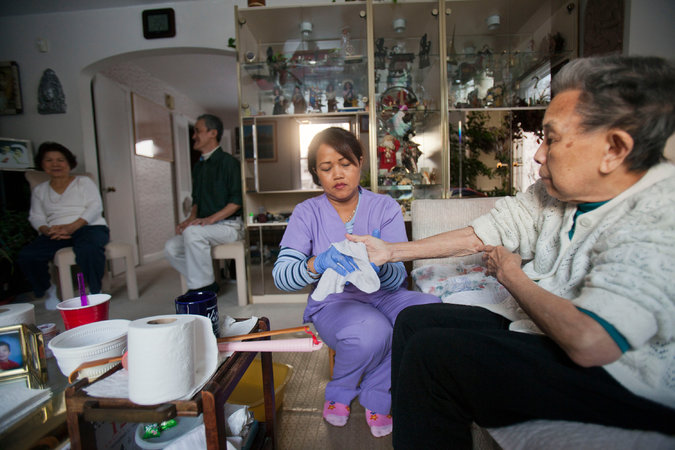This article by Tanzina Vega originally appeared in the New York Times

Savan Mok, a home health aide, assisting Oun Oy, 90, right, who had a stroke in 2012. Ms. Oy is from Cambodia and lives in Jenkintown, Pa., with her son and his wife, at rear. Jessica Kourkounis for The New York Times
SOUDERTON, Pa. — Two thick blankets wrapped in a cloth tie lay near a pillow on the red leather sofa in Phuong Lu’s living room. Doanh Nguyen, Ms. Lu’s 81-year-old mother, had prepared the blankets for a trip she wanted to take. “She’s ready to go to Vietnam,” Ms. Lu said.
But Ms. Nguyen would not be leaving. The doors were locked from the inside to prevent her from going anywhere — not into the snow that had coated the ground that day outside Ms. Lu’s suburban Philadelphia home, and certainly not to her home country, Vietnam.
Ms. Nguyen has Alzheimer’s disease, and Ms. Lu, 61, a manicurist who stopped working two years ago when her mother’s condition worsened, is her full-time caretaker. In Vietnam, children must stay home and care for their aging parents, Ms. Lu said. Elders “don’t want nursing home,” she said: Being in a nursing home creates “trouble in the head.” The family now relies financially on Ms. Lu’s husband, a construction worker.
In a country that is growing older and more diverse, elder care issues are playing out with particular resonance for many Asian-Americans. The suicide rate for Asian-American and Pacific Islander women over 75 is almost twice that of other women the same age. In 2012, 12.3 percent of Asian-Americans over 65 lived in poverty, compared with 9.1 percent of all Americans over 65. Nearly three-quarters of the 17.3 million Asians in the United States were born abroad, and they face the most vexing issues.
For the full article, which originally appeared in The New York Times click here
The opinions expressed in this article are those of the author and do not necessarily reflect those of the Diverse Elders Coalition.

